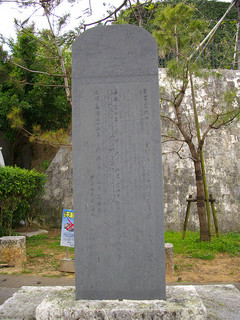Difference between revisions of "Kokuo shotokuhi"
| Line 1: | Line 1: | ||
[[Image:Kokuo-shotokuhi.jpg|right|thumb|320px|A reconstruction of the ''kokuô shôtoku-hi'', which stands outside [[Shuri castle]] today]] | [[Image:Kokuo-shotokuhi.jpg|right|thumb|320px|A reconstruction of the ''kokuô shôtoku-hi'', which stands outside [[Shuri castle]] today]] | ||
| − | *''Erected: [[ | + | *''Erected: [[1522]]'' |
*''Japanese'': 国王頌徳碑 ''(koku ou shou toku hi)'' | *''Japanese'': 国王頌徳碑 ''(koku ou shou toku hi)'' | ||
| − | The ''kokuô shôtoku-hi'' (lit. "stele of poem of the king's virtue") is a stele erected in [[ | + | The ''kokuô shôtoku-hi'' (lit. "stele of poem of the king's virtue") is a stele erected in [[1522]] which stands just outside the [[Shureimon]] main gate of [[Shuri castle]], the royal palace of the [[Ryukyu Kingdom|Ryûkyû Kingdom]]. It is, for that reason, also known as the "''Ishijô no higashi no himon''," or "Stele to the East of the Stone Gate [to the palace]." |
The inscription, by [[Sengan]], sixth abbot of [[Engaku-ji (Okinawa)|Engaku-ji]], praises King [[Sho Sei (尚清)|Shô Sei]], who had the road paved running from the shrine at [[Bengadake]]<!--弁ヶ嶽-->, the highest point in [[Naha]], to Shuri castle, and had pine trees planted all along its length. The inscription on one side of the stele is written in [[classical Chinese]], and that on the other side in a combination of ''[[kanji]]'' and ''[[kana]]''. The latter reads in part: | The inscription, by [[Sengan]], sixth abbot of [[Engaku-ji (Okinawa)|Engaku-ji]], praises King [[Sho Sei (尚清)|Shô Sei]], who had the road paved running from the shrine at [[Bengadake]]<!--弁ヶ嶽-->, the highest point in [[Naha]], to Shuri castle, and had pine trees planted all along its length. The inscription on one side of the stele is written in [[classical Chinese]], and that on the other side in a combination of ''[[kanji]]'' and ''[[kana]]''. The latter reads in part: | ||
| Line 11: | Line 11: | ||
''Shuri okiyakamoi ganashi no miyo ni miyako yori chiganemaru mikoshi mitama no watari môshi sôrô toki ni tatemôshi sôrô hinomon'' | ''Shuri okiyakamoi ganashi no miyo ni miyako yori chiganemaru mikoshi mitama no watari môshi sôrô toki ni tatemôshi sôrô hinomon'' | ||
| − | "Stele erected on the occasion of the dispatch from Miyako of a sword named '[[Chiyoganemaru|Chiganemaru]]' and sacred beads during the reign of King [[Sho Shin|Shô Shin]]."<ref>Text, romanization, and translation from ''Okinawa bijutsu zenshû''.</ref> | + | "Stele erected on the occasion of the dispatch from [[Miyakojima|Miyako]] of a sword named '[[Chiyoganemaru|Chiganemaru]]' and sacred beads during the reign of King [[Sho Shin|Shô Shin]]."<ref>Text, romanization, and translation from ''Okinawa bijutsu zenshû''.</ref> |
The stele is believed to have been erected in commemoration of that occasion. Other elements of the inscription include a proscription against self-immolation following the king's death. | The stele is believed to have been erected in commemoration of that occasion. Other elements of the inscription include a proscription against self-immolation following the king's death. | ||
| − | The open area around the stele came to be known as ''Himun-nu-mo'' ("Hair of the Stele Inscription"), and beginning in 1935 it came to be the terminal of the Naha-Shuri bus line. The stele was destroyed in the 1945 Battle of Okinawa; a reconstruction stands | + | The open area around the stele came to be known as ''Himun-nu-mo'' ("Hair of the Stele Inscription"), and beginning in 1935 it came to be the terminal of the Naha-Shuri bus line. The stele was destroyed in the 1945 Battle of Okinawa; a reconstruction stands to the east side of the Shureimon and [[Sonohyan utaki]] today, alongside a reconstruction of another stele known as ''[[Madama minato himon]]'', also originally erected in that location the same year. Both have been reconstructed based on surviving portions of the original, and on other surviving stelae. |
{{stub}} | {{stub}} | ||
Revision as of 23:14, 3 February 2020

- Erected: 1522
- Japanese: 国王頌徳碑 (koku ou shou toku hi)
The kokuô shôtoku-hi (lit. "stele of poem of the king's virtue") is a stele erected in 1522 which stands just outside the Shureimon main gate of Shuri castle, the royal palace of the Ryûkyû Kingdom. It is, for that reason, also known as the "Ishijô no higashi no himon," or "Stele to the East of the Stone Gate [to the palace]."
The inscription, by Sengan, sixth abbot of Engaku-ji, praises King Shô Sei, who had the road paved running from the shrine at Bengadake, the highest point in Naha, to Shuri castle, and had pine trees planted all along its length. The inscription on one side of the stele is written in classical Chinese, and that on the other side in a combination of kanji and kana. The latter reads in part:
首里おきやかもいがなしの御代にみやこよりち金丸みこしみ玉のわたり申候時にたて申候ひのもん
Shuri okiyakamoi ganashi no miyo ni miyako yori chiganemaru mikoshi mitama no watari môshi sôrô toki ni tatemôshi sôrô hinomon
"Stele erected on the occasion of the dispatch from Miyako of a sword named 'Chiganemaru' and sacred beads during the reign of King Shô Shin."[1]
The stele is believed to have been erected in commemoration of that occasion. Other elements of the inscription include a proscription against self-immolation following the king's death.
The open area around the stele came to be known as Himun-nu-mo ("Hair of the Stele Inscription"), and beginning in 1935 it came to be the terminal of the Naha-Shuri bus line. The stele was destroyed in the 1945 Battle of Okinawa; a reconstruction stands to the east side of the Shureimon and Sonohyan utaki today, alongside a reconstruction of another stele known as Madama minato himon, also originally erected in that location the same year. Both have been reconstructed based on surviving portions of the original, and on other surviving stelae.
References
- Okinawa bijutsu zenshû 沖縄美術全集. vol. 4. Okinawa Times, 1989. Description of Plates 81-82.
- Plaques on-site.[1]
- ↑ Text, romanization, and translation from Okinawa bijutsu zenshû.
